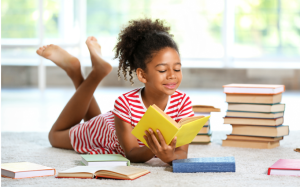Making Grand-Friends
The concept of “non-family intergenerational interactions” is centered around the simple idea that old and young can bring new energy, knowledge and enthusiasm to each others’ lives. Prior to the COVID-19 pandemic, we had a relationship with a retirement community, where several of their residents would travel to our preschool regularly to read and play with the children. Since restrictions have been lifted, the Caterpillar Clubhouse Nature Preschool children have been traveling to the retirement community instead, every other week, to visit their grand-friends.
I was in awe that the simple presence of our preschoolers made such a difference in these grand-friends lives. I noticed how the kids completely accepted the physical and mental differences around them with such natural grace. And gained a sense of connection across the generations. Too often we underestimate the power of a hug, smile and children’s laughter…. I believe in the respect and dignity of life for people of all ages, young and old. This core belief is the thread interwoven through the fabric of our program.
What the groups do when they meet can be as relaxed as playing with play dough, a balloon game or reading a book together.
Valuing Older People
Older adults have a need to contribute to the next generation, and that doing so can give older people feelings of accomplishment or success, rather than stagnation, as they age. Intergenerational activities show elders that they are valued as individuals that still possess lifelong skills, rather than being passive recipients of care. One lady who attended the care facility told me that you don’t think about your age when you are in the company of young children. The little ones brought a new sense of vibrancy and fun to the center, and the focus was no longer on watching time pass but on living in the moment.
These days traditional families are separated by distance, time and lack of understanding between generations, but programs that bring children and older adults together could change the whole of society’s outlook.
Early Childhood Education is about building relationships. Research shows that students who have healthy intergenerational relationships have better self-confidence as well as a greater sense of empathy and tolerance. Children also develop a positive sense of aging and the interactions between generations reduce fear of older adults. Relationships between the children and elders also reduce fear of various abilities and disabilities.
Quote of the day: Grand-friend: I didn’t even know I needed that hug until I just received it.
Preschool students, Primrose residents find friendship in one another | News | kokomotribune.com
DEIBJ stands for Diversity, Equity, Inclusion, Belonging, and Justice. It is the way we work towards a program and society that values all voices and includes all people. Though there are some who believe that young children should not learn about DEIBJ because they are too young and aren’t born with prejudices, we know from research that children as young as six months old will show a preference for faces of their own racial group– the beginnings of “in-group/out group” designation. However, that effect is reduced when the infants grow up in diverse neighborhoods.
New film by Debbie LeeKeenan and John Nimmo available to stream for free!
Wonderful resources and opportunity to reflect on anti-bias education
Reflecting on Anti-bias Education in Action: The Early Years features vignettes of anti-bias strategies in early childhood classrooms interspersed with teachers reflecting on their practice. Debbie and John partnered with filmmaker Filiz Efe McKinney of Brave Sprout Productions to create a film that shifts the focus away from the talking heads of experts and on to the voices of teachers committed to equity on a daily basis. By taking viewers into diverse early childhood classrooms, the film seeks to demonstrate the importance of teacher reflection on identity, context, and practice in anti-bias education and provides a much-needed resource for teacher education and professional development.
Adapted from Janet Gonzalez-Mena and Navaz Bhavnagri these questions are helpful for providers to self reflect when struggling with a family’s practice, that is different than their own.
This reading from the Head Start Early Childhood Learning and and Knowledge Center for Cultural and Linguistic Responsiveness revisits the Multicultural Principles handbook from 1991. It provides updated research and information on key points including:
- Culture has an influence on the beliefs and behaviors of everyone.
- Culture is passed from generation to generation.
- Culture is dynamic and changes according to the contemporary environment.
- Home language is a key component of children’s identity formation.
- Successful programs respect and incorporate the cultures of children and families.
The first principle is “Every individual is rooted in culture”. To view all of the updated principles visit ECLKC.
This resource offers tips for choosing culturally responsive books for children and how to check for stereotyping and bias. There is a worksheet included that can be used when evaluating a children’s book and links to other helpful resources. Check out the Head Start National Center on Cultural and Linguistic Responsiveness for more information and resources.
Selecting Culturally Appropriate Books Resource
Read this story by Patricia Grace that reminds us to be open to different experiences, ideas, and cultures.
John Nimmo is a professor of early childhood education at Portland State University and the co-author of Leading Anti-bias Early Childhood Programs. Listen as he talks of how to incorporate meaningful materials in a home setting.




